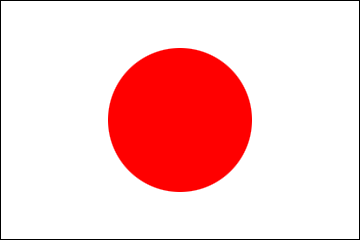"Craftsmanship of Japan: Sakai Forged Knives” presented by a French Blacksmith Mr. Eric Chevallier
2022/3/10
On March 10th, the Embassy of Japan held an online event titled “Craftsmanship of Japan: Sakai Forged Knives” presented by a French Blacksmith Mr. Eric Chevallier with a demonstration by Mr. HIRAKAWA Yasuhiro , 22nd generation blacksmith and Mr. Chevallier’s Master during his apprenticeship.
In his opening remarks, Ambassador KAWAMURA Yasuhisa said that Japanese knives are known around the world for their unique design, quality and sharp blades, thanks to expertise of blacksmiths using centuries old techniques. He remarked that the Japanese forged blades are not used exclusively by professional chefs and are used in a variety of fields, such as scissors for Ikebana and Bonsai.
Mr. Chevallier is a French blacksmith based in Sakai city, Japan, who founded DeSakai, a brand of traditional Japanese knives and kitchen tools, in 2012, also helps promoting Sakai’s brand to the foreign market as an inbound coordinator of Sakai City. During the webinar, he talked about the difference between various kinds of knives, including Deba and Nakiri knives, as well as the history of blacksmithing in the Sakai region.
As Mr. Chevallier narrated, Mr. Hirakawa gave a demonstration in his workshop, Sasuke. First, he showed the extreme levels of heat reached while forging scissors in the traditional way, using a particular kind of wood chips to achieve exactly the right effect. Mr. Chevallier explained how steel is folded over carbon to create a sturdy shape.
At the end of the event, many participants had questions and wanted to know more details about the traditional techniques for forging knives. It showed the demonstration and explanation were effective in increasing interest in Japanese knives.
The event is available at the link below:
Webinar "Craftsmanship of Japan: Sakai Forged Knives" | Facebook
In his opening remarks, Ambassador KAWAMURA Yasuhisa said that Japanese knives are known around the world for their unique design, quality and sharp blades, thanks to expertise of blacksmiths using centuries old techniques. He remarked that the Japanese forged blades are not used exclusively by professional chefs and are used in a variety of fields, such as scissors for Ikebana and Bonsai.
Mr. Chevallier is a French blacksmith based in Sakai city, Japan, who founded DeSakai, a brand of traditional Japanese knives and kitchen tools, in 2012, also helps promoting Sakai’s brand to the foreign market as an inbound coordinator of Sakai City. During the webinar, he talked about the difference between various kinds of knives, including Deba and Nakiri knives, as well as the history of blacksmithing in the Sakai region.
As Mr. Chevallier narrated, Mr. Hirakawa gave a demonstration in his workshop, Sasuke. First, he showed the extreme levels of heat reached while forging scissors in the traditional way, using a particular kind of wood chips to achieve exactly the right effect. Mr. Chevallier explained how steel is folded over carbon to create a sturdy shape.
At the end of the event, many participants had questions and wanted to know more details about the traditional techniques for forging knives. It showed the demonstration and explanation were effective in increasing interest in Japanese knives.
The event is available at the link below:
Webinar "Craftsmanship of Japan: Sakai Forged Knives" | Facebook
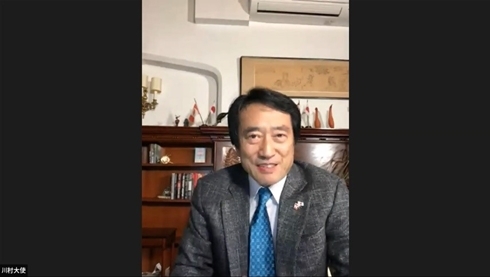 |
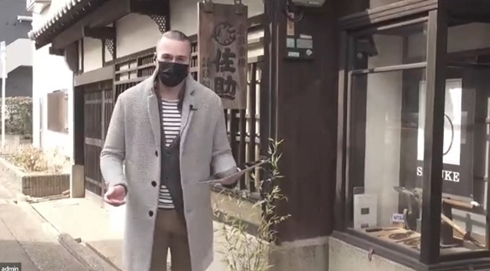 |
| Ambassador Kawamura giving his remarks |
Mr. Chevallier introducing the shop, “Sasuke.” |
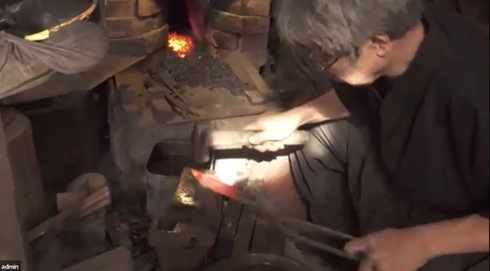 |
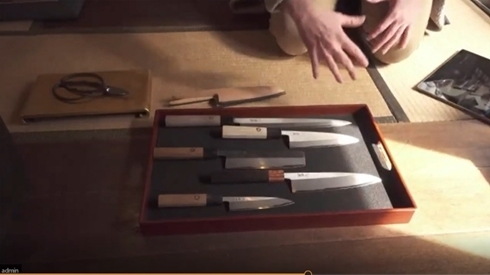 |
| Mr. Hirakawa showing the forging of a knife |
Mr. Chevallier explaining the characteristics of various kinds of knives and scissors |
 |
|
| Q&A session | |
Q&A session (Including replies posted by Mr. Chevalier after the event)
| 1 | What is the sharpening method for these knives? | ||||
| Thank you for your question. Materials used to make traditional blades are soft steel (low carbon, similar to iron for the knife body) and hard steel (high carbon steel for the edge). The sharpening method for these traditional carbon steel knives is the sharpening with wet stone. Until 6000 grind can be higher grind if reach mirror polishing. |
|||||
| 2 | Does Sasuke-san do all sharpening in house? or does some other sharpener sharpens like other Sakai blackstmiths? | ||||
| Thank you for your question. Sakai making process is usually separated between 4 craftsmen: The blacksmith, the sharpener, the handle maker and the seller. For scissors, Sasuke does all steps himself, but for knives he used to be just blacksmith. However, because his son finished an apprenticeship as sharpener, from last year, Sasuke does all steps in his shop, same for handle. |
|||||
| 3 | Do you think someday machines or new technology will be able to make this kind of traditional Japanese knife? | ||||
| Thank you for your question. Nowadays, we can make wonderful and good blades using machine so I think it can be possible a day but not yet. Plus, when you buy a knife, you buy also a story. Handmade knives like you can find at Sasuke or on DeSakai website have a soul. A passionate craftsman in an old traditional house putting his heart into the metal and suffering during the hot and humid Japanese summer or the really cold winter. If I am sure machine will be able to make similar knives a day, the story will be too boring. I think people want to get special tools made in few pieces and not industrial mass produced. |
|||||
| 4 | Where to buy these blades in Toronto Canada and how to keep them sharp and where to get them sharpened when necessary? | ||||
| Thank you for your question. Unfortunately Sasuke and DeSakai knives are unavailable in Canada because we make only few pieces. But you can purchase it on the website DeSakai or make an order to Sasuke on his page. To get them sharpened the best way is to get wet stones. I recommend 1000 and 4000 grind to get a good shape, but you can also ask to a Japanese specialist shop in Canada, they usually know how to sharp but be sure they use wet stone before. |
|||||
| 5 | Are these knives a “softer” or “harder” material? | ||||
| Japanese knives are harder material. But the most important is the marriage between the soft steel and the hard steel. The harder blade doesn’t mean it’s a good blade because it’s more fragile and hard to sharp. It’s better to have a good compromise like traditional handmade knives with both material not melt as some cheap knives but forged. |
|||||
| 6 | Is this one for Ikebana? | ||||
| Thank you for your question. Sasuke makes many types of scissors (15 types in many different sizes) But there is the main type: |
|||||
For gardening  |
For flowers |
For Ikebana |
For Bonsai  |
Shears |
|
| 7 | Does Sasuke_san make the handles of the knives himself too and what is the most expensive wood used for this purpose? | ||||
| Thank you for your question. Usual traditional magnolia wood handle with buffalo horn bolster are made by a famous handle maker in Sakai but for expensive piece, Sasuke’s son makes it himself. The most expensive at Sasuke is surely the ebony handle and Japanese quince wood. All with ebony or buffalo horn bolster. |
|||||
